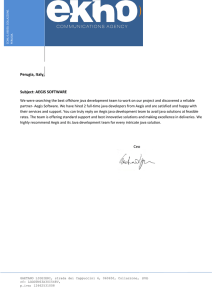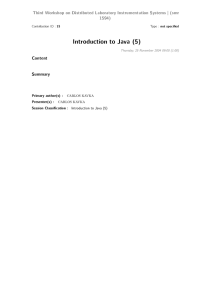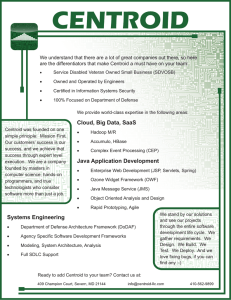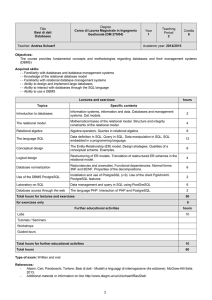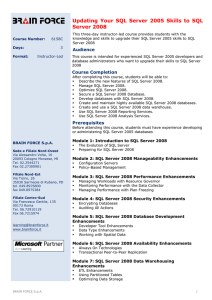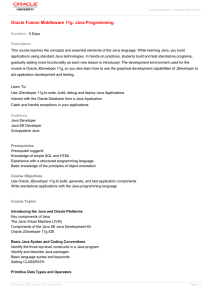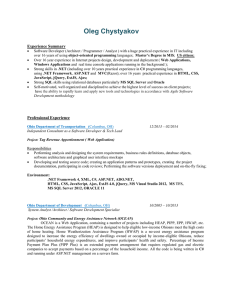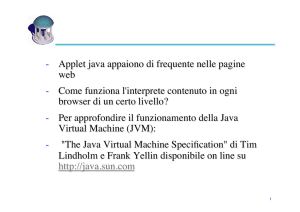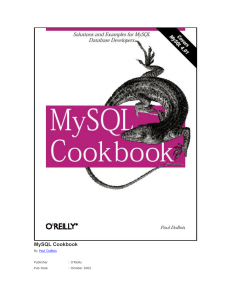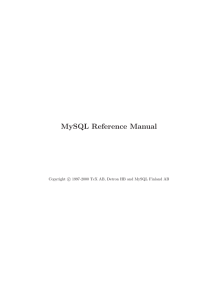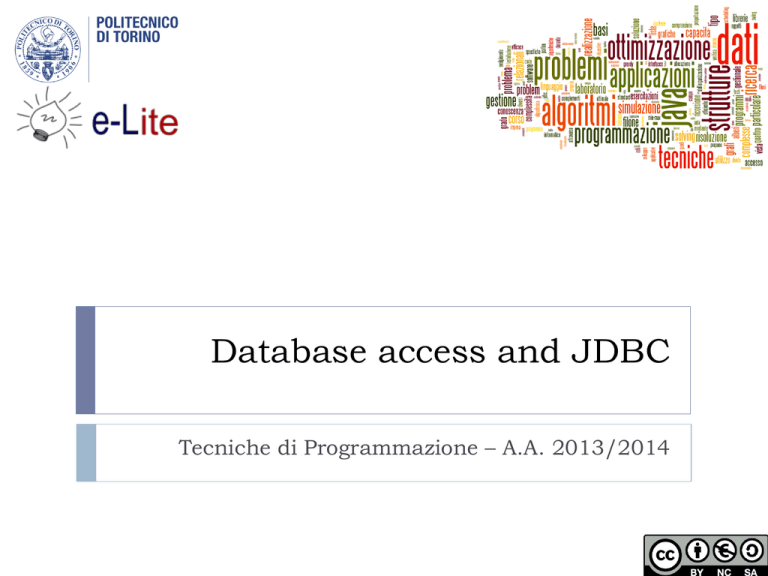
Database access and JDBC
Tecniche di Programmazione – A.A. 2013/2014
Outline
1.
2.
3.
4.
5.
Introduction to JDBC
Accessing a database: practical steps
Prepared statements
Design patterns (DAO)
Connection pooling
http://dilbert.com/strips/comic/1995-11-17/
2
Tecniche di programmazione
A.A. 2013/2014
Introduction to JDBC
Database access and JDBC
Goals
Enable Java applications to access data stored in
Relational Data Bases
Query existing data
Modify existing data
Insert new data
Data can be used by
4
The algorithms running in the application
The user, through the user interface
Tecniche di programmazione
A.A. 2013/2014
Goals (for Web Applications)
Access SQL DBMS’s from JSP pages
JDBC technology
Integrate SQL query results into the resulting HTML
content
Generate SQL queries according to FORM values
5
Tecniche di programmazione
A.A. 2013/2014
Goals (for GUI Applications)
Access SQL DBMS’s from the JavaFX application
JDBC technology
Load ‘massive’ data directly from database
Query ‘on-demand’ information from database
Store computation results
6
Tecniche di programmazione
A.A. 2013/2014
JDBC
Standard library for accessing relational databases
Compatible with most/all different databases
JDBC : Java Database Connectivity
Defined in package java.sql and javax.sql
Documentation:
7
http://www.oracle.com/technetwork/java/javase/tech/database137795.html
JDBC Overview:
http://www.oracle.com/technetwork/java/overview141217.html
Tecniche di programmazione
A.A. 2013/2014
JDBC scope
Standardizes
Mechanism for connecting to DBMSs
Syntax for sending queries
Structure representing the results
Does not standardize
8
SQL syntax: dialects, variants, extensions, ...
Tecniche di programmazione
A.A. 2013/2014
Architecture
9
Tecniche di programmazione
A.A. 2013/2014
Architecture
10
Tecniche di programmazione
A.A. 2013/2014
Main elements
Java application (in our case, JSP or JavaFX)
JDBC Driver Manager
JDBC Driver
For loading the JDBC Driver
From DBMS vendor
DBMS
11
In our case, MySQL
Tecniche di programmazione
A.A. 2013/2014
Accessing a database: practical
steps
Database access and JDBC
Basic steps
1.
2.
3.
4.
5.
6.
7.
13
Load the JDBC driver
Define the connection URL
Establish the connection
Create a statement object
Execute a query or update
Process the results
Close the connection
Tecniche di programmazione
A.A. 2013/2014
1. Loading the driver
A Driver is a DMBS-vendor provided class, that must be
available to the Java application
In general: Should reside in Project’s libraries
For JSP: Must reside in Tomcat’s CLASSPATH
The application usually doesn’t know the driver class
name until run-time (to ease the migration to other
DMBSs)
Needs to find and load the class at run-time
14
Class.forName method in the Java Class Loader (not needed in
recent versions)
Tecniche di programmazione
A.A. 2013/2014
MySQL JDBC driver
MySQL Connector/J
http://dev.mysql.com/downloads/connector/j/
Provides mysql-connector-java-[version]-bin.jar
Copy into CLASSPATH
E.g.: c:\Program files\...\jre…\lib\ext
Copy into project libraries
Copy into Tomcat’s libraries
The driver is in class
15
com.mysql.jdbc.Driver
Tecniche di programmazione
A.A. 2013/2014
Loading the MySQL driver
import java.sql.Connection;
import java.sql.DriverManager;
import java.sql.SQLException;
// Notice, do not import com.mysql.jdbc.* or you will have problems!
public class LoadDriver {
public static void main(String[] args) {
try {
// The newInstance() call is a work around for some
// broken Java implementations
Class.forName("com.mysql.jdbc.Driver").newInstance();
} catch (Exception ex) { // mostly ClassNotFoundException
// handle the error
}
}
16
Tecniche di programmazione
A.A. 2013/2014
Loading the MySQL driver
import java.sql.Connection;
import java.sql.DriverManager;
import java.sql.SQLException;
// Notice, do not import com.mysql.jdbc.* or you will have problems!
Note: in recent versions of the Java
LoadDriver
{ step is no longer needed.
JVM, this
public class
public static void main(String[] args) {
try {
// The The
newInstance()
call is
around for some
class is looked
upainwork
all the
// broken Java implementations
libraries (.jar) found in the CLASSPATH
Class.forName("com.mysql.jdbc.Driver").newInstance();
} catch (Exception ex) { // mostly ClassNotFoundException
// handle the error
}
}
17
Tecniche di programmazione
A.A. 2013/2014
2. Define the connection URL
The Driver Manager needs some information to connect
to the DBMS
The database type (to call the proper Driver, that we already
loaded in the first step)
The server address
Authentication information (user/pass)
Database / schema to connect to
All these parameters are encoded into a string
18
The exact format depends on the Driver vendor
Tecniche di programmazione
A.A. 2013/2014
MySQL Connection URL format
jdbc:mysql://[host:port],[host:port].../
[database][?propertyName1][=propertyValue1
][&propertyName2][=propertyValue2]...
19
jdbc:mysql://
host:port (localhost)
/database
?user=username
&password=ppppppp
Tecniche di programmazione
A.A. 2013/2014
3. Establish the connection
Use DriverManager.getConnection
Uses the appropriate driver according to the connection URL
Returns a Connection object
Connection connection =
DriverManager.getConnection(URLString)
Contacts DBMS, validates user and selects the database
On the Connection object subsequent commands will
execute queries
20
Tecniche di programmazione
A.A. 2013/2014
Example
import java.sql.Connection;
import java.sql.DriverManager;
import java.sql.SQLException;
try {
Connection conn = DriverManager.getConnection(
"jdbc:mysql://localhost/test?user=monty&password=secret");
// Do something with the Connection
....
} catch (SQLException ex) {
// handle any errors
System.out.println("SQLException: " + ex.getMessage());
System.out.println("SQLState: " + ex.getSQLState());
System.out.println("VendorError: " + ex.getErrorCode());
}
21
Tecniche di programmazione
A.A. 2013/2014
Class diagram
22
Tecniche di programmazione
A.A. 2013/2014
4. Create a Statement object
Statement statement =
connection.createStatement() ;
Creates a Statement object for sending SQL statements
to the database.
SQL statements without parameters are normally
executed using Statement objects.
For efficiency and security reasons, we will always use a
PreparedStatement object (see later…).
23
Tecniche di programmazione
A.A. 2013/2014
5. Execute a query
Use the executeQuery method of the Statement class
ResultSet executeQuery(String sql)
sql contains a SELECT statement
Returns a ResultSet object, that will be used to retrieve
the query results
24
Tecniche di programmazione
A.A. 2013/2014
Class diagram
25
Tecniche di programmazione
A.A. 2013/2014
Other execute methods
int executeUpdate(String sql)
For INSERT, UPDATE, or DELETE statements
For other SQL statements that don’t return a resultset (e.g.,
CREATE TABLE)
returns either the row count for INSERT, UPDATE or DELETE
statements, or 0 for SQL statements that return nothing
boolean execute(String sql)
26
For general SQL statements
Tecniche di programmazione
A.A. 2013/2014
Example
String query = "SELECT col1, col2, col3 FROM
sometable" ;
ResultSet resultSet =
statement.executeQuery(query) ;
27
Tecniche di programmazione
A.A. 2013/2014
6. Process the result
The ResultSet object implements a “cursor” over the query
results
Data are available a row at a time
The column values (for the selected row) are available trhough
getXXX methods
28
Method ResultSet.next() goes to the next row
getInt, getString, ...
Data types are converted from SQL types to Java types
Tecniche di programmazione
A.A. 2013/2014
Cursor
29
Tecniche di programmazione
A.A. 2013/2014
ResultSet.getXXX methods
XXX is the desired datatype
Must be compatible with the column type
String is almost always acceptable
Two versions
getXXX(int columnIndex)
getXXX(String columnName)
30
number of column to retrieve (starting from 1 – beware!)
name of column to retrieve
Always preferred
Tecniche di programmazione
A.A. 2013/2014
ResultSet navigation methods
boolean next()
Moves the cursor down one row from its current position.
A ResultSet cursor is initially positioned before the first row:
31
the first call to the method next makes the first row the current row
the second call makes the second row the current row, …
Tecniche di programmazione
A.A. 2013/2014
Other navigation methods (1/2)
Query cursor position
32
boolean
boolean
boolean
boolean
isFirst()
isLast()
isBeforeFirst()
isAfterLast()
Tecniche di programmazione
A.A. 2013/2014
Other navigation methods (2/2)
Move cursor
33
void beforeFirst()
void afterLast()
boolean first()
boolean last()
boolean absolute(int row)
boolean relative(int rows) // positive or
negative offset
boolean previous()
Tecniche di programmazione
A.A. 2013/2014
Example
while( resultSet.next() )
{
out.println( "<p>" +
resultSet.getString(1) + " - " +
resultSet.getString(2) + " - " +
resultSet.getString(3) + "</p>" ) ;
}
34
Tecniche di programmazione
A.A. 2013/2014
Datatype conversions (MySQL)
These MySQL Data Types
Can always be converted to these
Java types
CHAR, VARCHAR, BLOB, TEXT, ENUM,
and SET
java.lang.String,
java.io.InputStream,
java.io.Reader, java.sql.Blob,
java.sql.Clob
FLOAT, REAL, DOUBLE PRECISION,
NUMERIC, DECIMAL, TINYINT,
SMALLINT, MEDIUMINT, INTEGER,
BIGINT
java.lang.String,
java.lang.Short,
java.lang.Integer,
java.lang.Long,
java.lang.Double,
java.math.BigDecimal
DATE, TIME, DATETIME, TIMESTAMP
java.lang.String,
java.sql.Date,
java.sql.Timestamp
35
Tecniche di programmazione
A.A. 2013/2014
Datatype conversions
36
Tecniche di programmazione
A.A. 2013/2014
7. Close the connection
Additional queries may be done on the same connection.
Each returns a different ResultSet object, unless you re-use it
When no longer needed, ResultSet resources can be freed by
‘closing’ it: resultSet.close()
When no additional queries are needed, close the
connection to the database:
37
connection.close() ;
Tecniche di programmazione
A.A. 2013/2014
Prepared statements
Callable statements
Database access and JDBC
What’s wrong with statements?
String user =
txtUserName.getText() ; // JavaFX
String user =
request.getParameter("username") ; // JSP
String sql = "select * from users where
username='" + user + "'" ;
Problems:
39
Security
Performance
Tecniche di programmazione
A.A. 2013/2014
Security risk
SQL injection – syntax errors or privilege escalation
Example
Username : '; delete * from users ; -select * from users where
username=''; delete * from
users ; -- '
Must detect or escape all dangerous characters!
Will never be perfect…
Never trust user-entered data. Never. Not once. Really.
40
Tecniche di programmazione
A.A. 2013/2014
SQL injection attempt
41
Tecniche di programmazione
A.A. 2013/2014
SQL injection attempt
http://xkcd.com/327/
42
Tecniche di programmazione
A.A. 2013/2014
Performance limitations
Performance limit
Query must be re-parsed and re-optimized every time
Complex queries require significant set-up overhead
When the same query is repeated (even with different
data), parsing and optimization wastes CPU time in the
DBMS server
43
Increased response-time latency
Decreased scalability of the system
Tecniche di programmazione
A.A. 2013/2014
Prepared statements
Separate statement creation from statement execution
At creation time: define SQL syntax (template), with
placeholders for variable quantities (parameters)
At execution time: define actual quantities for placeholders
(parameter values), and run the statement
Prepared statements can be re-run many times
Parameter values are automatically
44
Converted according to their Java type
Escaped, if they contain dangerous characters
Handle non-character data (serialization)
Tecniche di programmazione
A.A. 2013/2014
Example
Connection connection =
DriverManager.getConnection(url, username, password);
String template =
"UPDATE music SET price = ? WHERE id = ?";
PreparedStatement statement =
connection.prepareStatement(template);
float[] newPrices = getNewPrices();
int[] recordingIDs = getIDs();
for(int i=0; i<recordingIDs.length; i++) {
statement.setFloat(1, newPrices[i]); // Price
statement.setInt(2, recordingIDs[i]); // ID
statement.execute();
}
45
Tecniche di programmazione
A.A. 2013/2014
Prepared statements
Easier to write
Secure (no SQL injection possible)
Quoting is done by JDBC library
More efficient
Data type conversion done by JDBC library
Query re-use
Parameter values sent in binary form
The bottom line: Always use prepared statements.
46
Tecniche di programmazione
A.A. 2013/2014
Callable statements
Many DBMSs allow defining “stored procedures”, directly
defined at the DB level
Stored procedures are SQL queries (with parameters), or
sequences of queries
Language for defining stored procedures is DBMS-dependent:
not portable!
MySql: http://dev.mysql.com/doc/refman/5.5/en/storedprograms-views.html (chapter 18)
Calling stored procedures: use CallableStatement in JDBC
47
Example: http://dev.mysql.com/doc/refman/5.5/en/connector-jusagenotes-basic.html#connector-j-examples-stored-procedure
Tecniche di programmazione
A.A. 2013/2014
Design patterns (DAO)
Database access and JDBC
Problems
Database code involves a lot of «specific» knowledge
Bad practice to «mix» this low-level information with
main application code
Connection parameters
SQL commands
The structure of the database
Reduces portability and maintainability
Creates more complex code
Breaks the «one-class one-task» assumption
What it a better code organization?
49
Tecniche di programmazione
A.A. 2013/2014
Goals
Encapsulate DataBase access into separate classes, distinct
from application ones
DataBase access should be indepentent from application
needs
All other classes should be shielded from DB details
Potentially reusable in different parts of the application
Develop a reusable development patterns that can be
easily applied to different situations
50
Tecniche di programmazione
A.A. 2013/2014
Data Access Object (DAO) – 1/2
«Client» classes:
Application code that needs to access the database
Ignorant of database details (connection, queries, schema, ...)
«DAO» classes:
51
Encapsulate all database access code (JDBC)
The only ones that will ever contact the database
Ignorant of the goal of the Client
Tecniche di programmazione
A.A. 2013/2014
Data Access Object (DAO) – 2/2
Low-level database classes: DriverManager, DataSource,
ResultSet, etc
Used by DAO (only!) but invisible to Client
«Transfer Object» (TO) or «Data Transfer Object»
(DTO) classes
52
Contain data sent from Client to Dao and/or returned by
DAO to Client
Represent the data model, as seen by the application
Usually POJO or JavaBean
Ignorant of DAO, ignorant of database, ignorant of Client
Tecniche di programmazione
A.A. 2013/2014
DAO class diagram
53
Tecniche di programmazione
A.A. 2013/2014
DAO Sequence diagram
54
Tecniche di programmazione
A.A. 2013/2014
DAO design criteria
DAO has no state
DAO manages one ‘kind’ of data
Uses a small number of DTO classes and interacts with a small
number of DB tables
If you need more, create many DAO classes
DAO offers CRUD methods
No instance variables (except Connection - maybe)
Create, Read, Update, Delete
DAO may offer search methods
55
Returning collections of DTO
Tecniche di programmazione
A.A. 2013/2014
public interface/class UserDAO
public User find(Long id)
public boolean find(Long id, User u)
public boolean find(User u) // uses u.id
public User find(String email, String
password)
public List<User> list()
List<User> searchUserByName(String name)
56
List<User> searchByName(User u) ; // only
u.name matters
Tecniche di programmazione
A.A. 2013/2014
public interface/class UserDAO
public void create(User user)
public Long create(User user) // returns new
ID
public void update(User user) // modify
all except ID
public void delete(User user)
public boolean existEmail(String email)
public void changePassword(User user)
57
Tecniche di programmazione
A.A. 2013/2014
Connection pooling
Database access and JDBC
Connection pooling
Opening and closing DB connection is expensive
Requires setting up TCP/IP connection, checking authorization,
…
After just 1-2 queries, the connection is dropped and all partial
results are lost in the DBMS
Connection pool
59
A set of “already open” database connections
DAO methods “lend” a connection for a short period, running
queries
The connection is then returned to the pool (not closed!) and
is ready for the next DAO needing it
Tecniche di programmazione
A.A. 2013/2014
JDBC 3.0 Connection pooling architecture
60
Tecniche di programmazione
A.A. 2013/2014
Benchmarks
The first time,
the connections
must be created
10x slower
61
Second time,
reuse
connections
No
improvement
Tecniche di programmazione
Negligible
overhead
Linear
increase
A.A. 2013/2014
Support in J2EE and Tomcat
The Java EE Platform Specification requires:
Java EE Application Servers must provide a DataSource
implementation
DataSource is a connection pool for JDBC connections
Tomcat implements this specification
DataSource – interface javax.sql.DataSource
62
Alternative to DriverManager
DataSOurce implementations can be located through JNDI
(Java Naming and Directory)
Tomcat implements a simplified JNDI service
Tecniche di programmazione
A.A. 2013/2014
Configure JNDI
Tomcat’s JNDI is stored in WEB-INF/web.xml
Define a resource to access a DataSource object, with a
symbolic reference name
<resource-ref>
<description>
Resource reference to a factory for java.sql.Connection
instances that may be used for talking to a particular
database that is configured in the <Context> configuration
for the web application.
</description>
<res-ref-name>jdbc/TestDB</res-ref-name>
<res-type>javax.sql.DataSource</res-type>
<res-auth>Container</res-auth>
</resource-ref>
63
Tecniche di programmazione
A.A. 2013/2014
Configure the connection factory
Implementation instructions are stored in METAINF/context.xml
<Context ...>
...
<Resource
name="jdbc/TestDB"
auth="Container"
type="javax.sql.DataSource"
maxActive="100"
maxIdle="30"
maxWait="10000"
username="utente1" password="utente1"
driverClassName="com.mysql.jdbc.Driver"
url="jdbc:mysql://localhost:3306/nazioni?autoReconnect
=true"
/>
...
</Context>
64
Tecniche di programmazione
A.A. 2013/2014
Get a connection from the pool
Lookup the DataSource, then get a new connection
/* JNDI query to locate the DataSource object */
Context initContext = new InitialContext();
Context envContext =
(Context)initContext.lookup("java:/comp/env") ; // JNDI
standard naming root
DataSource ds = (DataSource)envContext.lookup("jdbc/TestDB");
/* Ask DataSource for a connection */
Connection conn = ds.getConnection();
... use this connection to access the database ...
conn.close() ; // return connection to the pool
65
Tecniche di programmazione
A.A. 2013/2014
c3p0 library for connection pooling
Open source library for adding connection pooling
capabilities to JDBC drivers
http://www.mchange.com/projects/c3p0/
Connection Pooling
Prepared Statement Pooling
66
Automatically caches, recognizes and re-uses previously used
prepared statements
Tecniche di programmazione
A.A. 2013/2014
Using c3p0
import com.mchange.v2.c3p0.*;
The DataSource object:
cpds.getConnection()
lends a connection from the pool
...
ComboPooledDataSource cpds = new ComboPooledDataSource();
cpds.setDriverClass( "org.postgresql.Driver" );
//loads the jdbc driver
cpds.setJdbcUrl( "jdbc:postgresql://localhost/testdb" );
cpds.setUser("dbuser");
cpds.setPassword("dbpassword");
67
Tecniche di programmazione
A.A. 2013/2014
Closing up
To release a connection to the pool:
connection.close() ;
…otherwise the pool will run out of available connections!
To destroy the connection pool and clean up resources:
68
cpds.close();
Also disconnects from database.
May be placed in a stop() method in the main JavaFX class
Tecniche di programmazione
A.A. 2013/2014
References
JDBC Basics: Tutorial
JDBC reference guide
http://docs.oracle.com/javase/tutorial/jdbc/TOC.html
http://pdf.coreservlets.com/Accessing-Databases-JDBC.pdf
http://docs.oracle.com/javase/6/docs/technotes/guides/jdbc/gets
tart/GettingStartedTOC.fm.html
JDBC JavaDoc
69
http://docs.oracle.com/javase/6/docs/api/java/sql/packagesummary.html
http://docs.oracle.com/javase/6/docs/api/javax/sql/packagesummary.html
Tecniche di programmazione
A.A. 2013/2014
References
DAO pattern
70
http://www.oracle.com/technetwork/java/dataaccessobject138824.html
http://www.corej2eepatterns.com/Patterns2ndEd/DataAccessO
bject.htm
http://en.wikipedia.org/wiki/Data_Access_Object
http://balusc.blogspot.it/2008/07/dao-tutorial-data-layer.html
Tecniche di programmazione
A.A. 2013/2014
References
Connection pooling
71
Introduction:
http://www.datadirect.com/resources/jdbc/connectionpooling/index.html
with MySql Connector/J: http://dev.mysql.com/techresources/articles/connection_pooling_with_connectorj.html
http://dev.mysql.com/doc/refman/5.5/en/connector-jusagenotes-j2ee.html#connector-j-usagenotes-tomcat
Tomcat tutorial: http://tomcat.apache.org/tomcat-5.5-doc/jndiresources-howto.html#JDBC%20Data%20Sources
c3p0 - JDBC3 Connection and Statement Pooling:
http://www.mchange.com/projects/c3p0/
Tecniche di programmazione
A.A. 2013/2014
Licenza d’uso
Queste diapositive sono distribuite con licenza Creative Commons
“Attribuzione - Non commerciale - Condividi allo stesso modo (CC
BY-NC-SA)”
Sei libero:
Alle seguenti condizioni:
di riprodurre, distribuire, comunicare al pubblico, esporre in pubblico,
rappresentare, eseguire e recitare quest'opera
di modificare quest'opera
Attribuzione — Devi attribuire la paternità dell'opera agli autori
originali e in modo tale da non suggerire che essi avallino te o il modo in
cui tu usi l'opera.
Non commerciale — Non puoi usare quest'opera per fini
commerciali.
Condividi allo stesso modo — Se alteri o trasformi quest'opera, o se
la usi per crearne un'altra, puoi distribuire l'opera risultante solo con una
licenza identica o equivalente a questa.
http://creativecommons.org/licenses/by-nc-sa/3.0/
72
Tecniche di programmazione
A.A. 2013/2014


